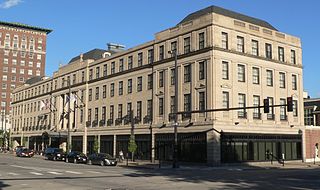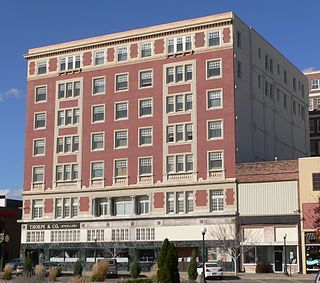
Omaha is the most populous city in the U.S. state of Nebraska and the county seat of Douglas County. Omaha is in the Midwestern United States on the Missouri River, about 10 mi (15 km) north of the mouth of the Platte River. The nation's 40th-most populous city, Omaha's 2020 census population was 486,051.

Eppley Airfield, also known as Omaha Airport, is an airport in the midwestern United States, located three miles (5 km) northeast of downtown Omaha, Nebraska. On the west bank of the Missouri River in Douglas County, it is the largest airport in Nebraska, with more arrivals and departures than all other airports in the state combined. It is classified as a medium hub airport by the Federal Aviation Administration (FAA). It is owned and operated by the Omaha Airport Authority (OAA).

North Omaha is a community area in Omaha, Nebraska, in the United States. It is bordered by Cuming and Dodge Streets on the south, Interstate 680 on the north, North 72nd Street on the west and the Missouri River and Carter Lake, Iowa on the east, as defined by the University of Nebraska at Omaha and the Omaha Chamber of Commerce.

Thomas Rogers Kimball was an American architect in Omaha, Nebraska. An architect-in-chief of the Trans-Mississippi Exposition in Omaha in 1898, he served as national President of the American Institute of Architects from 1918 to 1920 and from 1919 to 1932 served on the Nebraska State Capitol Commission.
Cabanne's Trading Post was established in 1822 by the American Fur Company as Fort Robidoux near present-day Dodge Park in North Omaha, Nebraska, United States. It was named for the influential fur trapper Joseph Robidoux. Soon after it was opened, the post was called the French Company or Cabanné's Post, for the ancestry and name of its operator, Jean Pierre Cabanné, who was born and raised among the French community of St. Louis, Missouri.

The Elms Hotel and Spa is a historic resort hotel at Regent and Elms Boulevard in Excelsior Springs, Missouri. It is listed on the National Register of Historic Places. It is located in The Elms Historic District.
Eugene C. Eppley also known as Gene, was a hotel magnate in Omaha, Nebraska. Eppley is credited with single-handedly building one of the most successful hotel empires, by the 1950s the largest privately owned hotel chain in the United States.
The Eugene C. Eppley Foundation was founded in Omaha, Nebraska. Founded by Omaha hotel magnate Eugene C. Eppley, the foundation was the leading benefactor for several charities and institutions in the Midwestern United States.
The DePorres Club was an early pioneer organization in the Civil Rights Movement in Omaha, Nebraska, whose "goals and tactics foreshadowed the efforts of civil rights activists throughout the nation in the 1960s." The club was an affiliate of CORE.
The Near North Side of Omaha, Nebraska is the neighborhood immediately north of downtown. It forms the nucleus of the city's historic African-American community, and its name is often synonymous with the entire North Omaha area. Originally established immediately after Omaha was founded in 1854, the Near North Side was once confined to the area around Dodge Street and North 7th Street. Eventually, it gravitated west and north, and today it is bordered by Cuming Street on the south, 30th on the west, 16th on the east, and Locust Street to the north. Countless momentous events in Omaha's African American community happened in the Near North Side, including the 1865 establishment of the first Black church in Omaha, St. John's AME; the 1892 election of the first African American state legislator, Dr. Matthew Ricketts; the 1897 hiring of the first Black teacher in Omaha, Ms. Lucy Gamble, the 1910 Jack Johnson riots, the Omaha race riot of 1919 that almost demolished the neighborhood and many other events.

Transportation in Omaha, Nebraska, includes most major modes, such as pedestrian, bicycle, automobile, bus, train and airplane. While early transportation consisted of ferries, stagecoaches, steamboats, street railroads, and railroads, the city's transportation systems have evolved to include the Interstate Highway System, parklike boulevards and a variety of bicycle and pedestrian trails. The historic head of several important emigrant trails and the First transcontinental railroad, its center as a national transportation hub earned Omaha the nickname "Gate City of the West" as early as the 1860s.

The Magnolia Hotel, formerly the Sheraton Omaha, was originally constructed as the Aquila Court Building, and is located at 1615 Howard Street in downtown Omaha, Nebraska. Built in 1923, it was listed on the National Register of Historic Places in 1974.
The Eppley Hotel Company was located in Omaha, Nebraska. At the time of its acquisition by the Sheraton Corporation in 1956, it had 22 properties, and it was the largest privately held hotel business in the United States.
John Latenser Sr. (1858–1936) was an American architect whose influential public works in Omaha, Nebraska, numbered in the dozens. His original name was Johann Laternser.
The Douglas House was the second hotel in Omaha, Nebraska. Located in present-day Downtown Omaha on the southwest corner of 13th and Harney Streets, the hotel housed influential politicians, speculators, and the first court trial in the Nebraska Territory. A two-story frame structure, it supplemented the earlier St. Nicholas Hotel.
The Irish in Omaha, Nebraska have constituted a major ethnic group throughout the history of the city, and continue to serve as important religious and political leaders. They compose a large percentage of the local population.

The Herndon House, later known as the International Hotel and then the Union Pacific Headquarters, was an early hotel located at Ninth and Farnam Streets in present-day Downtown Omaha, Nebraska. Built in 1858 by Omaha pioneer Dr. George L. Miller along with several associates, it was financed by the sale of city-donated land and a $16,000 loan. It was used as the headquarters building of the Union Pacific Railroad for more than 50 years; it was demolished in 1922.
The St. Nicholas Hotel, originally called the Claim House, was located near 12th and Jackson Streets in present-day downtown Omaha, Nebraska. It was the first building in Omaha, the first hotel, and hosted the first church service in Omaha. The Omaha Claim Club met in the building regularly, as well.
The First Nebraska Territorial Legislature first met in Omaha, Nebraska, on January 15, 1855. The Council Bluffs and Nebraska Ferry Company provided the first meeting place, which was a building "constructed for public purposes". Standing out from the estimated twenty shacks in the young town, it was the first brick building in Omaha, which was founded the year before when the Nebraska Territory was created. Responsible for several important decisions that laid an important foundation for the future statehood for Nebraska, the Nebraska Territorial Legislature made controversial decisions and provided leadership for the territory.

The Martin Hotel, erected as a Chicago style building in 1912, is located in Sioux City, Iowa. Added to the National Register of Historic Places in 1983, it is significant for its architecture, operating for many years as the Sheraton-Martin Hotel and now known as the Martin Tower Apartments.









